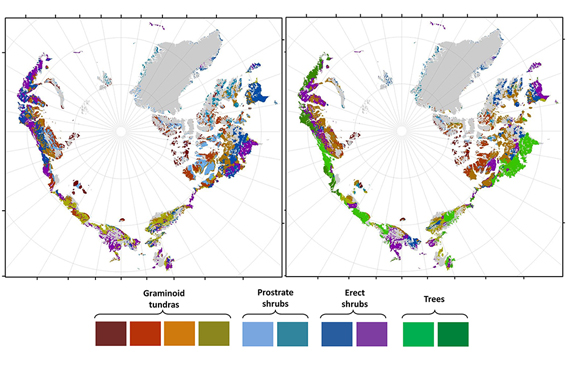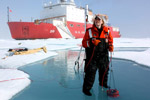
Arctic treeline site near Cherskiy in northeastern Siberia. A new study finds that the Arctic treeline will continue expanding northward as the region warms. Photo courtesy of Woods Hole Research Center.
Warming about twice as fast as the rest of the world, the Arctic is already undergoing massive upheavals from climate change: summer sea ice is thinning and vanishing, land based ice sheets are melting, and sea levels are rising. Now a new study in Nature Climate Change predicts that vegetation cover in the Arctic could expand by over 50 percent by 2050. Although increased vegetation would sequester additional carbon, this would be more-than-offset by the loss of the albedo effect, whereby sunlight bounces off white (snow and ice covered) parts of the Earth.
“Such widespread redistribution of Arctic vegetation would have impacts that reverberate through the global ecosystem,” notes lead author Richard Pearson, with the American Museum of Natural History’s Center for Biodiversity and Conservation.
Pearson and his team used computer modeling to predict how vegetation would expand and shift, based on temperature and precipitation, as the Arctic continues to heat up. Their findings predict that woody cover, i.e. trees and shrubs, would expand by 52 percent in less than 40 years. While it may sound, at first, like a positive development to see forests pop up in the Arctic, it will have major ramifications according to the scientists. A number of species depend on open tundra for survival, including several ground-nesting birds. In addition, the new forests would actually amplify global warming.
“Vegetation distribution shifts will result in an overall positive feedback to climate that is likely to cause greater warming than has previously been predicted,” the researchers write in the paper.
When solar radiation falls on this region much of it is bounced back into the atmosphere due to expansive snow cover; this is known as the albedo effect, which literally means “whiteness.” However, a rise in tall shrubs and trees—turning parts of the region from white to green and brown—will mean that previously deflected solar radiation will now begin to warm the Earth.
“Increased plant growth will not offset this warming effect because plants in the Arctic absorb atmospheric carbon relatively slowly,” says co-author Michael Loranty with Colgate University.
Global temperatures have risen about 0.8 degrees Celsius (1.4 degrees Fahrenheit) since the Industrial Revolution due largely to the burning of fossil fuels.

Arctic “greening”: Observed distribution (left) and predicted distribution of vegetation under a climate warming scenario for the 2050s (right). Data used to generate the observed image are from the Circumpolar Arctic Vegetation Map (2003). Click to enlarge.
CITATION: Richard G. Pearson, Steven J. Phillips, Michael M. Loranty, Pieter S. A. Beck, Theodoros Damoulas, Sarah J. Knight, and Scott J. Goetz. Shifts in Arctic vegetation and associated feedbacks under climate change. Nature Climate Change. doi:10.1038/nclimate1858
Related articles
Global warming to open new Arctic sea lanes
(03/05/2013) Rapidly melting sea ice in the Arctic due to global warming will open new shipping lanes that will speed transit between northern Asia, Europe, Canada and Alaska but unleash new safety, environmental and legal issues, according to scientists writing in this week’s issue of the Proceedings of the National Academy of Sciences.
Arctic sea ice volume plunges over a third in less than 10 years

(02/18/2013) Few places are changing as rapidly as the Arctic due to global warming. Last year, scientists were stunned when the Arctic’s seasonal ice extent fell to record low that was 18 percent below the previous one set in 2007. But new research in Geophysical Research Letters finds that the volume of ice is melting away just as quickly: satellite and ocean-based measurement have found that Arctic sea ice has fallen by 36 percent in Autumn since 2003. In winter, the ice volume has dropped 9 percent.
Reduction in snow threatens Arctic seals

(11/28/2012) Arctic snowfall accumulation plays a critical role in ringed seal breeding, but may be at risk due to climate change, according to a new study in Geophysical Research Letters. Sea ice, which is disappearing at an alarming rate, provides a crucial platform for the deep snow seals need to reproduce. Ringed seals (Phoca hispida) require snow depths of at least 20 centimeters (8 inches): deep enough to form drifts that seals use as birth chambers.
Arctic sea ice is ‘toast’ as old record shattered
(09/19/2012) Some twenty days after breaking the record for the lowest sea ice extent, the Arctic sea ice has hit a new rock bottom and finally begun its seasonal recovery. In the end, the Arctic sea ice extent fell to just 3.4 million square kilometers (1.32 million square miles) when only a few months ago scientists were wondering if it would break the 4 million square kilometers. The speed of the sea ice decline due to climate change has outpaced all the computer models, overrun all expert predictions, and shocked even the gloomiest scientists.
(08/16/2012) Four weeks before Greenland’s melting season usually ends, it has already blown past all previous records. By August 8th, nearly a month before cooler weather usually sets in around the world’s largest island, the island toppled the past record set in 2010.
Massive algae bloom in Arctic like “finding the Amazon rainforest in the Mojave Desert”

(06/11/2012) Given everything marine researchers know about phytoplankton, a type of algae, no one expected to find some of the world’s largest blooms beneath Arctic sea ice. But this is exactly what scientists stumbled on during an ICESCAPE expedition in the Chukchi Sea, which is examining the massive impacts of climate change in the region. Researchers recorded a 100 kilometer (62 miles) long bloom underneath the Arctic ice pack that was four times richer than adjacent ice-free waters.
Climate change creating “novel ecosystem” in Arctic
(06/06/2012) If melting sea ice and glaciers weren’t enough, now climate change is producing what researchers call a “structurally novel ecosystem” in the northwestern Eurasian tundra. Warmer weather and precipitation changes in the region, which covers western Russia into Finland, has allowed shrubs of willow and alder to grow into sparse forests within just forty years, according to a new study in Nature Climate Change. The new ecosystem could have global implications as researchers say it is likely to worsen global warming due to a decline in the region’s albedo, i.e. the sunlight reflected back into the atmosphere due to snow cover.













